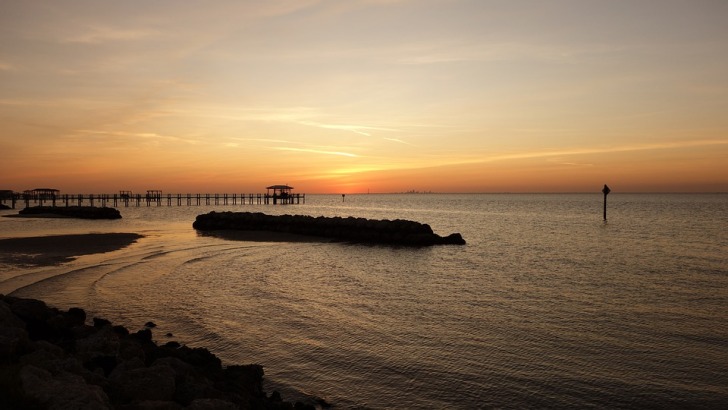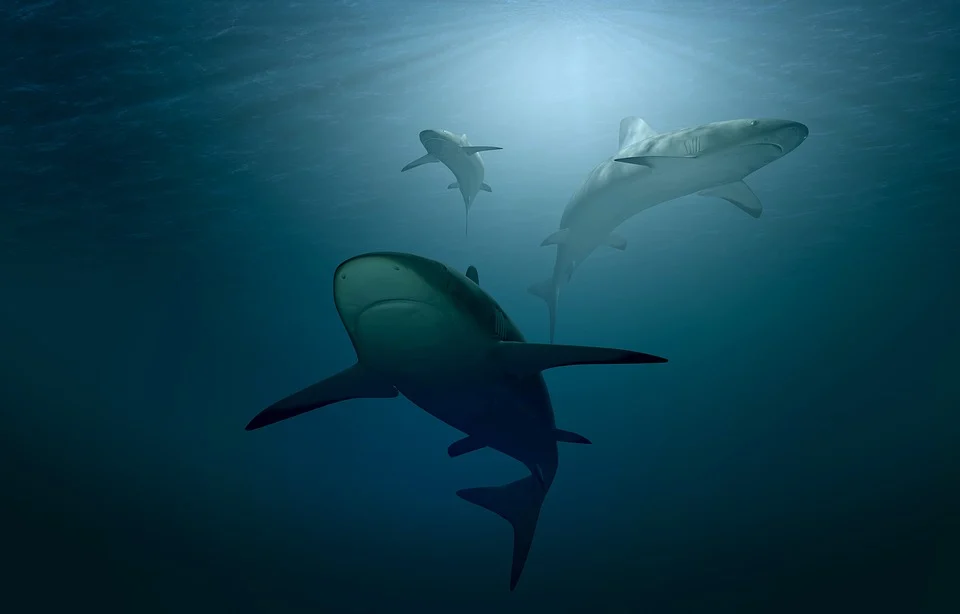Tampa Bay is ideally located for tourists who want to escape the cold for a warm vacation destination with a wide array of beach activities.
With its warm tropical weather and the gorgeous waters of Tampa Bay, this area is very popular for all kinds of water-related activities.
You can surf, fish, swim, and parasail, just to name a few, but should you be concerned that lurking underneath the water’s surface is one of the ocean’s most efficient predators?
Contents
- So… Are There Sharks in Tampa Bay?
- Shark Species in Tampa Bay
- Is it Safe to Swim in Tampa Bay?
- Interesting Shark Facts in Tampa Bay
- Sharks in Freshwater vs. Saltwater
- 3 Safety Tips for Swimming in Shark-infested Waters
- Sources
- Hold Up! What About Tampa, Is It Safe?
- Tampa Safety Overview
- Frequently Asked Questions
- How many people die every year from shark attacks?
- Is it safe to touch a shark?
- Do sharks lay eggs?
- How do sharks taste?
- Why should sharks be protected?
- How long do sharks live?
- Do sharks always have to swim to stay alive?
- Why do hammerhead sharks look so different?
- What is the largest shark?
- What is the smallest shark?
- Do all sharks dive deep?
So… Are There Sharks in Tampa Bay?
The truth is that sharks are pretty common in the Tampa Bay area.
Many species of sharks find this area to be not only a good environment year-round but also a preferable place for breeding and raising young.
This does not mean that the waters are teeming with sharks, but it does mean that anyone planning recreational activities in the bay should know a few facts and how to stay safe.

There are a dozen or so species of sharks that can be found in Tampa Bay.
Some of the more common species are bonnetheads, hammerheads, nurse sharks, tiger sharks, blacktips, lemon sharks, and bull sharks.
Bonnetheads, also known as shovelheads, typically grow to be about 48 inches or less in length.
They are a smaller member of the hammerhead family.
They are shy and tend to avoid areas with humans, so they do not pose any significant risk.
Hammerhead sharks are larger, with females growing as large as eight feet in length.
Despite having large heads, hammerheads have small mouths.
There are currently nine different species of hammerhead sharks and only three of these have ever been recorded to attack a human.
The possibility of a hammerhead attack is extremely rare.
In fact, because they are regularly hunted in some parts of the world for their fins, humans probably pose a higher risk to the hammerhead.
Many of the species that appear in Tampa Bay—nurse sharks, blacktips, and lemon sharks—do not have a history of posing a threat to humans.
Some, like the blacktip, prefer shallower waters, so they may be spotted by divers.
Of the shark species in Tampa Bay, the bull and tiger sharks may statistically pose the most risk, although even with their presence, attacks against humans are very rare.
Analysis of data related to shark attacks puts the odds of being attacked at about one in six million, and the rate of fatality due to shark attacks at one in 11.5 million.
People are far more likely to die by drowning.
Is it Safe to Swim in Tampa Bay?
As millions of Tampa Bay visitors and residents will tell you, swimming in Tampa Bay is very safe.
However, just like any area, swimmers should remain aware, not swim alone, and take a few common-sense precautions to ensure their safety.
Sharks may often feed in the hours around dawn and dusk, so it is best to avoid those times for swimming.
Also, pay attention to any beach staff and lifeguards.
They will alert swimmers and surfers if there is unusual shark activity in the area.
Abide by their advice.
As with any oceanic area, there are other ways to stay safe.
Pay attention to the tide schedule as well as weather and surf conditions.
If strong rip tides are posted, do not ignore these warnings.
If swimming is allowed but there are big waves, do not get in (literally) over your head.
Do not put yourself in situations beyond your ability.
Giant waves do not create the ideal conditions for learning to surf for the first time.
Learn about other animal species in the area that could hurt you.
In the Tampa Bay area, this means understanding what jellyfish look like and what to do if you see one washed up on the shore.
(Spoiler alert—do not touch it or poke it with anything.)

Interesting Shark Facts in Tampa Bay
With its prevalence of shark species, Tampa Bay has been called a shark nursery by many experts.
As the warmer, regional water temperatures of the summer fade into the fall, many shark species give birth to their pups.
Tampa Bay seems to have ideal conditions for their young to feed and reach maturity.
Many fishermen hope to catch a shark in the waters of Tampa Bay.
Nurse sharks, which make for tasty eating, are especially popular among sport fishermen.
You may also spot a smaller shark species leaping out of the water of the bay.
It is likely that this is a blacktip shark as they have been known to breach the surface of the water while pursuing fish to eat.
Tampa Bay is an estuary, which means it is a body where freshwater from streams and rivers flows into ocean water.
Most sharks thrive in saltwater environments.
There are a few species of sharks, including bull sharks, that can adapt to freshwater areas.
Although sightings can be rare, bull sharks have been found inland in freshwater riverways.
The temperature of Tampa Bay is ideal for sharks, but it is not merely an issue of the temperature that works best for their bodies.
Warmer water creates conditions that optimize the amount of fish and other prey for sharks.
It only makes sense that sharks follow the food chain and are drawn to warmer waters.

3 Safety Tips for Swimming in Shark-infested Waters
- Do not swim at dawn, dusk, or at night. These are prime feeding times for sharks, so let them have the water to themselves.
- Do not enter the water during the day if feeding conditions are present. This means that you should avoid swimming in areas where there is a lot of fishing going on. Between the bait being used and smaller fish on the line, these factors can attract sharks. It also means that you should not swim if you have open sores or are bleeding. The presence of blood in the water does attract sharks.
- Do not wear shiny jewelry or splash around a lot. Shiny objects resemble fish scales (and a shark’s dinner). Splashing around can attract the attention of larger shark species, like bull sharks. Splashing may resemble the actions of a seal or other prey.
There are plenty of opportunities to enjoy activities in Tampa Bay and, although it is an area that sharks migrate to, this should not prevent you from spending time in the water.
By exercising some common sense and listening to the safety experts around you, you can visit Tampa Bay and leave with a lot of great memories.
As marine biologists and other scientists expand their research on sharks, they continue to learn more about their migration patterns, lifespans, and eating habits.
While predicting the behavior of any species is never guaranteed, the more scientists learn, the more information they can provide to humans who want to occasionally share the same water as nature’s most perfect predator.
Sources
- https://baysoundings.com/tampa-bay-nursery-for-perfect-predators/
- https://www.animalspot.net/bonnethead-shark.html
- https://marinesanctuary.org/blog/scalloped-hammerhead-shark/
- https://www.sharksider.com/hammerhead-shark/
- https://everythingwhat.com/is-tampa-bay-freshwater-or-saltwater
- https://en.wikipedia.org/wiki/Freshwater_shark
- https://www.nature.com/articles/news030127-7
- https://www.floridamuseum.ufl.edu/discover-fish/sharks/
Hold Up! What About Tampa, Is It Safe?
Yes, sharks are dangerous, but let’s get back to land for a second.
Here’s our Tampa safety review:
Tampa Safety Overview
READ THE FULL REPORT: Tampa Safety Review
Safety Index:
- OVERALL RISK: MEDIUM
- TRANSPORT & TAXIS RISK: LOW
- PICKPOCKETS RISK: LOW
- NATURAL DISASTERS RISK: MEDIUM
- MUGGING RISK: MEDIUM
- TERRORISM RISK: MEDIUM
- SCAMS RISK: LOW
- WOMEN TRAVELERS RISK: LOW
Frequently Asked Questions
How many people die every year from shark attacks?
This number is very low.
According to the International Shark Attack Files (ISAF), in 2019, there were a total of 57 shark attacks worldwide.
Thirty-three of those attacks occurred in the United States.
Florida is the state where the most attacks occurred.
However, of the nine attacks that happened that year in Florida waters, six were in Volusia Country and three in Brevard County.
Both are located on the Atlantic coast side of the state.
Is it safe to touch a shark?
In a word, no.
If you see a shark while swimming or diving, the best thing to do is quietly and calmly leave the area.
Touching the shark may provoke it.
Do sharks lay eggs?
Some species of sharks do lay fertilized eggs.
Other species give birth to live juvenile sharks.
Baby sharks are called pups and litters are usually small, with five or fewer pups.
How do sharks taste?
There is a myth that sharks bump against their prey because they can “taste” them through their skin.
This is not true.
Sharks do have tongues, but that is not how they taste their food either.
Instead, they have tastebuds lining their mouth and throat.
Why should sharks be protected?
Sharks are what are known as apex predators, meaning they are at the top of the food chain in their environment.
They are important to the overall ecosystem of the ocean because they help keep fish populations regulated.
They may also feed on sick or older fish, so they help do their part to keep the oceans healthier.
How long do sharks live?
Some species of sharks can live to be almost 50 years old.
Whale sharks have been known to live for about 100 years!
Do sharks always have to swim to stay alive?
Not all sharks have to swim constantly in order to breathe.
Some species of sharks are able to rest and still have oxygen moving through their gills.
However, sharks do not sleep like humans.
Instead, they have active periods and rest periods.
Why do hammerhead sharks look so different?
Hammerhead sharks have a broad, flat head with eyes located on the outer edges and nostrils that are further apart than most sharks.
Although scientists are not sure, they believe that this structure may give the hammerhead shark some sensory advantages because they can move their large head from side to side while swimming and maximize their search area.
Because their nostrils are spaced further apart, they may have a better ability to track scent trails.
Hammerheads also have larger muscles in their heads than many other sharks, which gives them a great range of motion.
It also allows them to move more quickly to pursue prey.
What is the largest shark?
The whale shark is the largest, but that does not mean it is dangerous to humans.
Although it can grow to about 60 feet in length, the whale shark makes its meals completely of ocean plankton—tiny organisms carried by currents and tides.
What is the smallest shark?
The dwarf lantern shark is found primarily in the Caribbean and, at full maturity, is only about eight inches long.
Do all sharks dive deep?
Most sharks live at a relatively shallow depth their entire lives.
There are some species of sharks that dive deeper for short periods of time, perhaps to rest.
The deepest recorded dive was a goblin shark that dove to a depth of just under a mile.












Tampa is a popular tourist destination, and like any major city, it has its share of crime.
However, most of the crime in Tampa is non-violent, such as property theft and fraud.
As long as visitors use common sense and take precautions like avoiding isolated areas at night, they should have a safe and enjoyable experience in Tampa.
Overall, Tampa Bay is a beautiful destination with plenty to offer tourists, including a variety of beach activities.
Tampa is generally a safe city for tourists.
Like any major city, there are areas of concern, but overall, it is a welcoming and friendly place to visit.
The crime rate in Tampa is slightly higher than the national average, but it is still considered relatively low.
As with any destination, it is essential to be aware of your surroundings and take precautions to protect yourself and your belongings.
Overall, Tampa Bay is a great place to visit for a warm and sunny vacation with plenty of activities to enjoy, both on land and in the water.
Tampa Bay offers a perfect escape from the cold and a wide array of beach activities for tourists, making it an ideal vacation destination.
Yes, but they rarely pose a threat to humans.